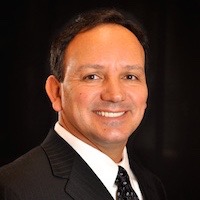Category Archives: Impact
How to double (or triple) your productivity in just ten minutes a day
Do you ever start your day feeling like you are already behind? Even though its morning, you wake up feeling stressed out, overwhelmed and itching to get a jump on things so you can bust through them.
Did you know that when you start your day in that state, the chances that you’ll accomplish much are slim at best?
There is a better way to access your best work that will allow you to not only get more done, but enjoy yourself in the process. And it can take as little as ten minutes a day. Watch this video to find out how.
Want more?
Check out the The Integrated Leader’s Guide to Freedom and Flow, a four week pilot program I am kicking off on May 2.
The program is designed to help high achieving leaders break out of feeling stressed, overwhelmed, and feeling at the mercy of their environments so they can access an optimal state where they can think more clearly, get more done in less time, access their best performance, and feel a greater sense of satisfaction and fulfillment with their work and lives overall.
Spaces are limited to 15 participants, and registration is closing on Friday, April 29. So be sure to act quickly!
How to Embrace Life’s Toughest Lessons and Come out on Top
Have you ever had one of those days/weeks/months where it felt like one darn thing after another?
It has been said that there is nothing more powerful than an idea whose time has come. But these ideas enter into us long before they are ready to be brought into the world. They prepare us, transform us, and lead us through a myriad of experiences that allow us to develop what we need in order to manifest them. These experiences are not always pleasant. We suffer disappointments, setbacks, frustrations. During times like these it is easy to feel as though life would be just fine as soon as these turbulences subside. But what if these little disturbances are the very things we need in order to breathe life into these visions that lie within us?
“The future enters into us in order to transform us, long before it happens.” ~ Rainer Maria Wilke
How many of the world’s greatest healers once experienced some kind of malady that they needed to overcome on their own before they had what it took to help others through the same challenge? How many people transcended their suffering by finding meaning in it and then went on to help others do the same? How many leaders rose to great heights charged with a mission of improving an organization or a community after having experienced something that needed to be changed?
If your journey as a leader will require you to exercise courage, you may find yourself in several situations that scare the hell out of you. If it requires you to show compassion, you may find yourself in situations where you must learn to transform your anger into something more constructive. You will continue to draw to yourself the experiences you need to develop what is required to bring your vision into the world. The blessing and the curse in all of this is that those experiences will continue to present themselves until you finally learn the things you need to learn.
“Sometimes what’s in the way is the way.” ~ Eckhart Tolle
Early in my career as an instructor and developer of courses and workshops, I realized that an effective learning experience required a balance of lecture and discussion with some kind of experiential activity that would allow participants to translate into action what they just learned in theory. Life has a beautiful way of doing this for us. The funny thing is that in the classroom no one ever much seemed to enjoy breaking into pairs and triads and having to practice something they were not very good at yet, and the same thing seems to be true when those experiences present themselves in our daily lives.
But life doesn’t give up on us. If it doesn’t go so well with one person or situation, we get another to practice on. And it doesn’t even matter so much how well we do with these challenges, as long as we show up and do what’s in front of us. We will continue to be given opportunities to choose different responses, learn from them and adapt our behavior once again.
Think about anything you ever had to learn. You began at the beginning. You started with the easy stuff. Then when you became stronger and more capable, you went onto a more advanced level, where the challenges were tougher and you had to apply greater skill, muscle and intellect. You emerged from each of these lessons with something you didn’t have before. And you couldn’t have acquired it through any other route than your own experience.
“Eighty percent of success is showing up.” ~ Woody Allen
As I began coaching executives several years ago, the emphasis in my work shifted from trying to impart a lesson to helping people learn from their own experiences and see the perfect order in which things are unfolding in their personal and professional lives to help them get where they truly want to go. The pertinent thing was no longer to give people answers, but rather to help them find their own and to recognize they already possess everything they need to get them through whatever challenge is before them. And this is something each of us can do as leaders to help those around us on their own journeys as well.
What is life trying to teach you or prepare you for right now? And how can you seize these opportunities in front of you to bring out your very best so that you can help someone else do the same?
Notice the people that you have feelings of admiration or annoyance with. They will tend to demonstrate qualities you have in yourself that you are in the process of developing or addressing in some way. When I ask people to identify the qualities in leaders they most admire, what they see is a reflection on some level of what is already within them at some level. Similarly, those who annoy us could represent something that we either need to integrate within ourselves, or resolve at some level.
have in yourself that you are in the process of developing or addressing in some way. When I ask people to identify the qualities in leaders they most admire, what they see is a reflection on some level of what is already within them at some level. Similarly, those who annoy us could represent something that we either need to integrate within ourselves, or resolve at some level.
Soft spoken people who get annoyed with those that are loud and assuming may need to integrate a bit of outspokenness to achieve a better balance. Overly aggressive people who find fault with others that are constantly trying to steal the stage may need to look at and tone down the ways they do this when they are with others.
Pay attention to the advice you find yourself impassionedly and repeatedly giving to others. It has been said that teachers teach best what they most need to learn. Often you will attract others to you that may need to learn it as well, however that doesn’t exclude you from the lesson. In fact, it is not uncommon for us to be surrounded by people who mirror our own issues and states of mind. Sometimes this annoys us, but it is only because we have difficulty accepting and addressing these things in ourselves.
Often, when I am at my most frenzied, I will have a meeting with a client that is having difficulty relaxing and letting go. As my clients recognize what they need to do to overcome their obstacles, I get great insights into my own as well. There are also meetings where clients feel as though someone else needs to start or stop some kind of action. It is not unusual to hear them identify the exact thing they really need to do for themselves, as they project it onto what they think others should do.
“We see the world not as it is, but as we are.” ~ Rainer Maria Wilke
Think of the most difficult people in your life as your teachers. I know, this is a tough one. But a funny thing happens when we try to avoid the difficult people in our lives. We can change jobs, organizations and even marriages, but over time we find ourselves surrounded with the same personalities and situations we fled from, only with different names and faces. In these situations, we need to show up even more fully to the challenges these people and situations present.
Life only gets more difficult when we resist them. Once we accept these people for who they are and ask ourselves what we can do to make the best of the situation, we find that we inevitably begin to discover qualities and resilience within us that we didn’t even know we had. Low and behold, we grow and evolve into better people because of it.
“The best way out is always through.”
~ Robert Frost
As we recognize and embrace the ways in which life teaches us, we stay in a flow that allows us to get where we need to be with less resistance and more ease and satisfaction. As leaders, we can help others do this for themselves as well. We need to resist any temptation to “save people” from challenging situations and instead help them find and unleash the qualities within them that will most assuredly allow them to rise above their difficulties and discover themselves to be greater than they realized.
For more on how to embrace life’s toughest lessons and come out on top, check out my book, The Pinocchio Principle: Becoming a Real Leader, available at Amazon.com and BarnesandNoble.com.
Seven Tips for Getting Out of Your Own Way and Doing Your Best Work
 My last post, The Little Known Secret to Superior Work, was about the resistance that often creeps in when we finally sit down to do that juicy project or idea that we’ve been waiting for just the right moment to develop. Whether it is driven by impatience, fear of failure or a need for perfection or control, what sucks all the joy out of work that could be immensely gratifying and inspiring for yourself and everyone around you is getting too fixated on the end result at the expense of being engaged in the process.
My last post, The Little Known Secret to Superior Work, was about the resistance that often creeps in when we finally sit down to do that juicy project or idea that we’ve been waiting for just the right moment to develop. Whether it is driven by impatience, fear of failure or a need for perfection or control, what sucks all the joy out of work that could be immensely gratifying and inspiring for yourself and everyone around you is getting too fixated on the end result at the expense of being engaged in the process.
Here are some tips for getting out of your own way the next time you feel stuck:
- Take a deep breath and relax. Roll your head around on your neck a few times. Smile. Take another breath and let it out slowly. Be right here, right now.
- Give yourself credit. You made this time. You showed up. You are still here. Focus more on what you are doing than on what you aren’t. Stay with it.
- Remember why you are doing what you are doing. What is your overarching intention? If all you can think about is the result you want to achieve, see if you can identify what having that result will give you. Even if that result is money you will earn, think about what that money will give you. In the end, it always comes down to a feeling. A feeling of well being, of satisfaction, of happiness. See if you can move into that feeling now. Have faith the results will take care of themselves. Now, come back to the process or experience itself and immerse yourself in it.
- Shift your focus from what you can get to what you can give. It is truly the only thing you really have any control over, and what you give to others has a way of giving back to you as well. This might be about sharing your knowledge with someone, or helping someone do something they couldn’t do before. It might be about partnering with others to create something that is bigger than yourself. The energy, vitality and goodwill you bring to your work will benefit you as much as everyone around you.
- Start small and don’t put a lot of pressure on yourself. Great writers often encourage other writers to start with “crappy first drafts.” Just get moving. Jot some notes down. Start anywhere. Create some momentum. Even if you are moving in the wrong direction, you can turn around with less effort than it takes to get started again. You can always fine tune and spruce things up later.
- Acknowledge your inner critic, but don’t let it steal the show. That harsh, judgmental voice may well always be there. Give it a nod and smile and then let it go – in much the same way you would screen out background noise that you can’t eliminate. Just because it’s there doesn’t mean it has to stop you – or that you have to pay any attention to it at all. Don’t judge yourself or your work. Move beyond your conscious mind to tap into your subconscious, where your intuition will guide you. Let it flow even if you are not sure where it is going and you may be pleasantly surprised at what happens next.
- Take a five to fifteen minute break every hour to ninety minutes. Stretch your body, rest your eyes, walk around a bit to keep your energy up and stay fresh.
If you need help getting out of your own way so you can do your best work, pick up a copy of my book The Pinocchio Principle: Becoming the Leader You Were Born to Be, available at Amazon.com or BarnesandNoble.com. If you are interested in working one on one with me, visit my website to learn more or contact me to schedule a complimentary coaching call.
Image courtesy of suphakit73 at FreeDigitalPhotos.net.
The Little Known Secret to Superior Work
 My last post, How to Not Become a Slave to Your To Do List, was written just as much for me as it was for you. So I took my own advice. I cleared space on my calendar. I eviscerated my to do list and calendared time to do the stuff I’ve been wanting to do for so long now. I scheduled time to work on my next book. And I finally sat down to do it.
My last post, How to Not Become a Slave to Your To Do List, was written just as much for me as it was for you. So I took my own advice. I cleared space on my calendar. I eviscerated my to do list and calendared time to do the stuff I’ve been wanting to do for so long now. I scheduled time to work on my next book. And I finally sat down to do it.
I opened a document and typed a few words. And then I stared at the blinking cursor for awhile. I took a deep breath, read what I had just written, then deleted it and typed something else in its place. But I didn’t like that either.
I reviewed some notes I had scribbled down a few days prior to see if I could get any inspiration. It didn’t help. My gaze went from my screen to my keyboard, where my hands were perched, ready and agile. Still nothing.
I saw an email notification in the corner of my screen. Resisting the urge to check my inbox, I closed my Outlook program.
And I sat for several more minutes. Stuck. Maybe this isn’t the best time. Maybe I should go do something else for awhile. At that moment, anything sounded preferable. I could trim my fingernails, reorganize my desk drawers, mow the lawn. Or the neighbor’s lawn.
But no. I was committed to this. It is something I had been wanting to do for a really long time. Why was it so flipping hard?
Have you ever felt that way?
It’s no wonder that we let so many other things get in the way of taking the time to do our real work. Our real work requires us to face our deepest fears and make our way through our toughest resistance – in the presence of our worst critics.
As soon as you make the commitment to do something important – for yourself, for others, for the world – rest assured anything that has ever stopped you before will come back in your face with an exponential force.
I didn’t get a whole lot written in that particular block of time. But I showed up. I didn’t run away. And I have to say that after awhile things did begin to flow. I strung a few paragraphs together and once I let go and gave in to the experience, I was delighted with a couple of really great insights that came spilling onto the page. It went in a direction I hadn’t anticipated and began to take on a life of its own.
Talking with a friend a few days later, I began to realize what it was that got me stuck.
I was fixated on results at the expense of the process. I had become too attached to the end product and what it was going to get me. I had ideas in my mind of what it would – should – look like. And I was judging every little thing I was (and wasn’t doing). If you can envision a small child being led to a table and told to do something, while a rather large, imposing figure stood over her with a club at her head yelling in a booming voice – you have a pretty good idea of the dynamic I had created for myself. My child was rebelling. My critic was becoming more and more agitated. And neither of us really wanted to be there at all.
Perhaps you’ve heard artists or musicians talk about how they could never quit their day job to earn a living doing their craft. “It would just suck all the joy out of it,” they may tell you. The problem isn’t so much that they would be paid for doing what they love as it is that they risk having their focus go from the joy of being in the process to becoming too dependent on the result. The irony is that when you detach from the result altogether and become immersed in the experience, the results tend to take care of themselves.
Superior work is created when you are engaged in what you are doing rather than what it will lead to or where it will get you.
If you have ever played golf or tennis, think about what happens when you allow your attention to go prematurely to the target before you’ve hit the ball. You will have a crappy shot. (You may even miss the ball altogether.) But when you devote yourself to the process – when you are present in your body through every part of your swing, when you follow through and trust that the ball will go right where you intend it to – you have the opposite experience.
The same is true with just about anything. Companies that focus solely on profits often neglect their customers, their employees or both and spend more time worrying about how to increase their market share and their bottom line than on the quality of their product. Conversely, those who make it a priority to listen to their customers and employees and create cultures where people do their best work are often rewarded with a loyal following.
Comedians who desperately need a laugh often aren’t all that funny or entertaining, while those who stop worrying about what people think and have a good time on stage end up captivating their audiences and leaving them wanting more. Artists who sacrifice their passion to pander to the crowd risk producing shallow, uninspiring work, while those who pour their hearts into what they do engage the hearts of others.
When all your attention and energy goes toward the end result, you vacate the process – along with all the energy, passion and unique gifts that go into creating something really special and valuable. Your end product will feel somewhat empty or hollow. And it is very likely that you will too.
The good news is that the wall created by a fixation on results at the expense of the process is self imposed. Which means that you have the ability to dismantle it. In my next post, Seven Tips for Getting Out of Your Own Way and Doing Your Best Work I’ll share seven tips for breaking through that wall the next time you are stuck.
“It is good to have an end to journey to. But it is the journey that matters in the end.”
– Ursula K. LeGuin
Image courtesy of Sira Anamwong at FreeDigitalPhotos.net.
The Dark Side of To Do Lists
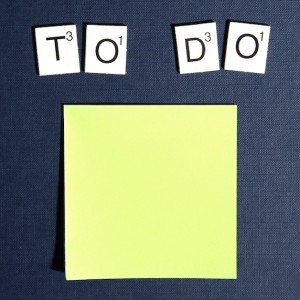 Like many, I found that making lists of things to do has a certain appeal. It helps me feel organized. It keeps me from forgetting things. It allows me to ensure that stuff will get done. And it gives me a perverse pleasure to check off the boxes.
Like many, I found that making lists of things to do has a certain appeal. It helps me feel organized. It keeps me from forgetting things. It allows me to ensure that stuff will get done. And it gives me a perverse pleasure to check off the boxes.
But there are some major drawbacks to these lists. Here are just a few disadvantages of to do lists that I’ve discovered:
- There is a temptation to add things to the list that just don’t really need to be there.
- You have a tendency to think that the things on your to do list all have to be done by you and you alone.
- You may feel like you cannot rest until you get to the bottom of your to do list, which never really happens… EVER.
- You run the risk of judging yourself by the number of tasks you have accomplished – regardless of whether those things are really important or meaningful.
- Crossing things off your to do list provides an artificial sense of accomplishment that fades quickly and leaves you feeling like you can’t rest until you do more.
- Your to do list can become your master. The tool you created to help you get things done is used a weapon that you end up beating yourself with when you don’t execute it as planned.
- To do lists keep you busy running from one thing to the next without checking in with yourself on what you really need or WANT to do.
- The things you really WANT to do rarely end up on your to do list – they end up getting delayed or neglected altogether (see How Your To Do List Keeps You From Living the Life You Were Meant to Live).
- Your to do list leaves you feeling justified for playing small and never going out of your comfort zone to try something that could ultimately be the best thing you ever did for yourself and everyone around you.
- Your to do list can keep you fixated on achieving results without really enjoying or being present for the process or the experience of what you are doing (which ironically leads to sucky results anyway).
- You run the risk of putting more importance on knocking things off your list than spending time with the important people in your life (and unconsciously communicating to them that they are not a priority).
- You fail to recognize all the many blessings you have in your life because you are so fixated on all the things you think you need to do to be happy.
If you need help breaking free of your to do list and living the life you really want to live, stay tuned for my next post – “How Not To Be A Slave to Your To Do List.”
Five Steps for Getting and Staying Out of the Weeds
 In my last post, I wrote about the dynamic of getting stuck in the weeds, like the debris that clings to the side of a river instead of floating along with the current. It piles up and attracts other debris, and grows ever more stagnant and smelly.
In my last post, I wrote about the dynamic of getting stuck in the weeds, like the debris that clings to the side of a river instead of floating along with the current. It piles up and attracts other debris, and grows ever more stagnant and smelly.
Are you stuck in the weeds? Do you find yourself working really hard, but not getting much done? Do you hear yourself saying at the end of the day, “Well, I didn’t get to what I really needed/wanted to do today, but there’s always tomorrow.” And then uttering those words again the next day? And the day after that too?
We are all called to live lives of greater meaning, purpose and significance. It beckons to us each and every day. When we answer that call, we feel energized, invigorated and deeply gratified. And when we hesitate and resist, we are tired, overwhelmed and frustrated.
The problem is that we don’t always realize when we have strayed off course until we find ourselves stuck in the weeds, becoming dormant and becoming increasingly irritated with ourselves, our lives, and everything/everyone around us.
This can happen at home or at work when a project takes us out of our comfort zone and into procrastination. It can happen in relationships when we resist taking things to a deeper level and play it safe instead, or in critical conversations with others when we dance around the real issues and stay mired in placing blame or trying to save face. And it can happen in our very lives as we trade out our grandest dreams and visions for doing what gets us by and allows us to go through the motions of staying busy instead of doing what we are really here to do.
The problem we are really talking about is RESISTANCE.
Resistance rears its head when we face something that we fear will lead to pain or discomfort. When we embark on a great endeavor, resistance has us thinking of all the things that could go wrong rather than all that we have to gain by simply moving forward. It conjures up all manner of horrible human emotions – embarrassment, inadequacy, fear, humiliation, defeat, abandonment, betrayal – you name it, and has us doing anything it can to avoid experiencing them.
Resistance would have us playing it safe. Planning, preparing, orchestrating, controlling. It has us clinging to that which is familiar – even if the familiar isn’t all that pleasant. Resistance leads us to sedate or control our emotions rather than simply feeling and experiencing them. In resistance, we cling to the banks of the river instead of courageously flowing with the current.
The irony is that it actually takes more effort and energy to resist than to be in the flow.
And in the end, the pain that resistance causes is far worse than anything it would have you avoid.
Here are five steps for getting and staying out of the weeds and overcoming the resistance that keeps you from living the life you were meant to live.
(1) Take responsibility. As I said in my last post, when we find ourselves in the weeds, it is surely a result of a decision we made at some point to stay in our comfort zone. This decision could have been a decision made in default – like the kind of decision we make when we decide not to decide. Once we make the decision to play small, we get distracted by anything that will keep us there. Though we tend to blame the distractions for knocking us off course, they are really just the outcomes of what we have decided (often unconsciously) to focus our attention on.
This step is vital because without it, you will relegate yourself to being a victim and convince yourself that you are powerless and immobilized. See beyond this self imposed illusion and recognize that you always have the ability and opportunity to choose again.
(2) Choose again. Envision the state you would like to be in at any given moment. Pull your head out of the weeds and look at the horizon. What do you really want for yourself? What do you want to create? What do you want to feel? What do you want to experience? Maybe this is a matter of remembering the goals you set for yourself the last time you paused long enough to think about them. Perhaps it is a matter or revisiting or creating your personal mission or vision for your personal and professional life. It could be as simple as identifying what you would like to be experiencing in this moment.
Whatever it is, make it real for yourself. Step into it. Flesh it out. Feel it. Embrace it. Become it. Sometimes it helps to remember the last time you felt whatever it is you want to experience and relive it once again. Talking about it with people who inspire and believe in you can help you to reconnect with what you really want for yourself and breathe new life into it. Try writing it down and moving deeper and deeper into it. Go back and re-read what you wrote and add more as it comes to you.
(3) Make a commitment to yourself. There is a difference between wishing and committing. You can wish for a better life. You can wish for a great relationship and a brilliant future. You may be interested in trying something new, learning to do something different, creating something fun and exciting. All this is nice, but it won’t keep you out of the weeds until you commit. Committing is making the empowering decision to live the life you have imagined. It isn’t about being anything that you are not, but rather embracing and expressing all that you are without allowing anything to get in your way.
Scottish mountaineer and writer William Hutchinson Murray wrote, “Until one is committed, there is hesitancy, the chance to draw back, always ineffectiveness. Concerning all acts of initiative (and creation), there is one elementary truth, the ignorance of which kills countless ideas and splendid plans: that the moment one definitely commits one-self, then providence moves too. All sorts of things occur to help one that would never otherwise have occurred. A whole stream of events issues from the decision, raising in one’s favor all manner of unforeseen incidents and meetings and material assistance, which no man could have dreamed would have come his way.”
(4) Let go and listen. We are brought up to believe that in order to get anything done, we need to get out there and make it happen. We spend a great deal of time trying to pound square pegs into round holes and plan our future by reacting to things that happened in the past. We are uncomfortable with uncertainty and have lived a good portion of our lives trying to mitigate it by controlling everything in our reach. But the future is by definition, uncertain. And our attempts to maintain control will send us to the river bank, clinging to the sides in an attempt to hold on and assert the illusion of power. It will keep us stuck in the familiar, resistant to moving beyond the expanses of what we think we already know.
True power lies in admitting that we do not have all the answers, and are willing and ready to learn. We begin asking bigger questions and listening for new information. This is what the greatest inventors, scientists, artists, musicians and geniuses in all fields have done throughout the history of time. It requires us to tune into a new way of knowing, one that goes beyond having to figure everything out and instead learning to discern the answers that we already have within. We learn to feel our way to where we want to go, balancing our logic with intuition and taking one step at a time rather than having to figure everything out in advance.
(5) Trust. The resistance we experience whenever we embark upon something extraordinary is really just fear of the unknown. The worst case scenario our resistance would have us conjuring up is only a show stopper when it has us believing we wouldn’t be able to handle it. As leaders, our job is to instill confidence in others – that we all have what it takes to rise up to any challenge we may be faced with, that we can overcome any obstacle in our path. But we cannot do this for others until we first do it for ourselves. Being willing to let go and flow with the current requires trust in something bigger than ourselves that is working in our highest good. And it requires faith in ourselves and our ability to persevere, adapt and thrive in any environment we find ourselves in.
To find this trust and faith, we would do well to reflect on the events of our lives that have led us to where we are today. Regardless of the peril we faced, the uncertainty we had to navigate through, and the fear we may have experienced, we have arrived at the point we are now. The sum of our experiences, whether pleasant or not has perfectly prepared us for all that lies before us in this moment.
We will inevitably find ourselves in the weeds from time to time. There is no shame in that; we are free stay there as long as we like. But when living that way is no longer enough, we have the power and the ability to recommit, trust and allow ourselves to flow with the current of adventure in our lives – one that has the power to bring us to the realization of all our greatest dreams and visions.
Image courtesy of Evgeni Dinev at FreeDigitalPhotos.net
Are You Caught in the Weeds? Five Telltale Signs and The Danger that Lurks There
“I have so much going on that I can’t seem to make headway on anything. And then there is another fire that needs tending to, and another one after that. I never seem to have a chance to get to the really important things I have to do. I go home at the end of the day  exhausted, only to wake up and do it all over again.”
exhausted, only to wake up and do it all over again.”
Sound familiar? I think at one time or another we have all echoed that refrain. I hear it often from clients. And I have uttered it myself as well.
When you are in it, you feel stuck. Immobilized. In some cases, victimized. It may seem as though there is just no way out. And sometimes it really is unavoidable. But in most cases, this condition is not only self imposed, but self perpetuated.
“What?” You might say. “You really think I’m choosing this?”
Well, yes it’s very possible. Maybe not consciously. Perhaps not intentionally.
One day I was sitting on the bank of a little creek that runs through the edge of our neighborhood. The water flows fairly quickly – it’s a bit of a babbling brook. Every once in awhile there are ducks floating by – and sometimes their little fluffy ducklings following closely behind. Debris floats along too. And if you look at the sides of this little stream of water, occasionally the debris piles up on the side and gets stuck in the weeds that grow along the edges. The longer it stays there, the more stagnant it becomes. And then it seems to grow, collecting other debris that float into it.
I think that’s what happens to us when we lose sight of where we are going. We get distracted by something that takes us out of the flow and snags our attention and our focus. And once off course, we tend to become susceptible to all manner of diversions. It doesn’t seem like a big deal until we find ourselves ensnared and feeling trapped.
Why do we do this?
When there is some big endeavor we want to undertake, we usually start bright eyed and energized. And as we get further into things, we may find ourselves hitting walls. Sometimes the obstacles are a normal part of the process, and other times we have unwittingly placed them there ourselves. When plagued by feelings of overwhelm or fear of failure, we begin to shrink from the possibilities that initially lit us up and instead crawl into the shadows. Then we unwittingly propagate the very conditions that lead us to feel stuck.
The real problem is that before we got sucked into the distraction, we made an unconscious decision to stay in our comfort zone. The kind of decision I’m referring to is one where we decide not to decide. It’s a default we revert to when we let our fear, doubt and limiting assumptions get the better of us. We take our eye off the ball, leaving ourselves susceptible to all manner of distractions. And the distractions most likely to entice us are those that allow us to stay in our comfort zones, while perpetuating the illusion that we are getting something done.
Though the distraction seems to justify the decision to do something other than the brilliant feat we set out to accomplish, it was not actually the cause. The decision to stay in our comfort zone is what attracts all manner of little things into our path – those little things that are annoying and time consuming – but all too familiar.
You know you are in the weeds when the things you find yourself doing:
- Things that don’t require a lot of skill on your part – they are banal, yet comfortable and familiar
- Things that would be better delegated to others, or in some cases not done at all
- Things that drain your energy and expand in size to suck up far more of your time than you thought they would
- Things that have very little, if anything, to do with the larger vision and goals you hold dear for yourself
- Things that begin to make you feel as though you are slowly going out of your mind
I have seen this happen to teams who start out to launch a strategic endeavor and get caught up in identifying, labeling, categorizing, and even wordsmithing all manner of details that really won’t matter all that much in the long run.
I see this happening to my clients when they begin making progress toward some great vision and get sucked into fighting fires by reverting back to doing the operational work they did before they became leaders (or leaders of leaders) instead of empowering their people to work through these challenges themselves.
And I have seen it in myself when I commit to getting something off the ground that has beckoned to and inspired me for weeks or months, only to get sucked into going through my emails and spending hours trying to resolve technical issues that would only take others (who knew what they were doing) a matter of minutes.
So once in this trap, how do you free yourself? And better yet, how can you avoid falling into it altogether?
Well, the first step is to take responsibility. We have to be honest with ourselves about our role in the situation. It takes us out of victim mode and allows us to recognize that a large part of our experiences are directly related to the decisions (conscious and unconscious) we have made. And it frees us up to choose differently.
My next post, Five Steps for Getting and Staying Out of the Weeds, will give you a concrete approach for staying the course that will allow you to step into your brilliance and unearth your best work. In the meantime, consciously observe the way your actions and your thoughts perpetuate the state you find yourself in – and you may begin to see the way out for yourself.
Image courtesy of puttsk at FreeDigitalPhotos.net
Why Goals Will Only Get You Part Way There — and How to Bridge the Gap
Each year, we instinctively feel the opportunity and invitation to begin anew. One year is over and another has begun, bringing with it the sweetness of infinite possibility. One way of giving form to these possibilities is to create New Year’s Resolutions. While it is traditional to make these resolutions at the beginning of the year, the truth is that we can start anytime, anywhere. In fact, a study from the University of Scranton actually found that setting resolutions in January wasn’t as effective as creating them in other times of the year, because people often tend to feel pressure to set them without being prepared to carry them out.
It all begins with a desire. Sometimes that desire is an aspiration to reach higher by beginning something new, and other times it is a determination to go to the next level of effectiveness with things we’re already doing.
To create powerful resolutions that are aligned with our highest good, we need to find a way to pull ourselves out of the daily grind and into a space that is big enough fo r our hearts and minds to roam freely. It requires that we carve out time to be alone for awhile, so that we can reacquaint ourselves with what’s most important in our lives and tune into what is beckoning to be discovered or unearthed. In these moments, we can reflect, inquire, and dream. And we can reconnect with the inner wisdom we all possess that provides the guidance we need to transform vision into reality.
r our hearts and minds to roam freely. It requires that we carve out time to be alone for awhile, so that we can reacquaint ourselves with what’s most important in our lives and tune into what is beckoning to be discovered or unearthed. In these moments, we can reflect, inquire, and dream. And we can reconnect with the inner wisdom we all possess that provides the guidance we need to transform vision into reality.
I’ve always found that for some reason, being in an airplane allows me to find clarity. As the ground gets further and further away, the little things that consumed my attention before I left seem to get smaller and smaller just like the cars and buildings that slowly disappear out of view. And then I am flying. Suddenly I feel as though it is easier to see a bigger picture. Things fall into place in my mind and I feel energized and optimistic. I have discovered that climbing mountains and retreating into nature can have a similar effect.
With intention and conscious effort, I believe we can create this experience anywhere, anytime. The key is to allow our minds to rise above the clamor we are usually surrounded by so that we can get a broader view of our lives and from that perspective see things we may have previously missed. And this is exactly what we need to do before we can rise above anything else. Albert Einstein said we cannot solve our problems with the same thinking with which they were created. When we allow ourselves to get this higher perspective, we can go beyond looking at things to examine the very lens through which we are looking — and make any necessary adjustments.
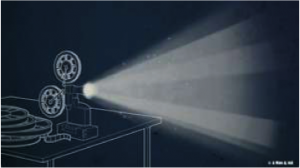
Our mindsets are like giant projectors. What we see and do in our lives is based on the movies we are playing and the roles in those movies that we have cast ourselves in.
You can’t expect to be the hero in your adventure if the movie in your mind is a horror flick or tear jerker that has you playing the victim. So when we set goals, it is not enough to commit ourselves to acting in new ways. We must also think in new ways. The other day I heard someone refer to New Year’s resolutions as the opportunity to resolve — or re-solve anything that is holding us back. And this is exactly what we must do.
It comes down to whatever we identify most with. If you want to use your time more effectively but you identify with the experience of running late and feeling harried as you rush from one thing to another, it is only a matter of time before your actions will mirror your mindset. Despite your time management system, you will likely continue to over commit yourself, try to squeeze too many things in, or make more efficient things that really shouldn’t be done at all.
However, if you begin to experience what it would feel like to think from the mindset of someone who always seems to get the most important things done and have ample time to enjoy life and everything in it, you will make different decisions, know intuitively what you must let go of and come up with actions and habits that support your new way of thinking. And you are far more likely to have lasting success.
Upon reflection, I realized that I long for more simplicity and peace in my life, as well as the ability to boldly tackle new endeavors without making them into huge feats that leave me exhausted and overwhelmed. I have noticed that I have a tendency to complicate and resist some of the things that I know are good for me, but that I am scared of for one reason or another. In the past I’ve allowed my fear to make things much harder than they need to be — probably so that I can rationalize my resistance to them.
It will not be enough for me to set a goal to simplify more, complicate less, and take bolder action. I need to change my mindset from someone who is overwhelmed and overly cautious and fearful about big, bold endeavors to someone who has clear resolve, determination and a lightness that allows me to take myself and everything I do less seriously.
The other day a handyman came over to fix a dozen or so things that I have been procrastinating for months. Every time I looked at that list, I felt weighed down. I never intended to actually fix them all myself, but for whatever reason even thinking about it felt heavy (similar to how some of my major projects have felt.) As I watched this man spring into action, easily taking care of one thing after another in a matter of minutes and cheerfully coming back to the list to see what was next, I realized that he has the mindset that I need.
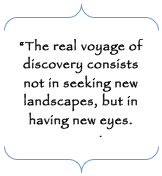 What would it be like to see from that perspective? What would it feel like to power through important projects and new endeavors with such lightness? That is what I need to get my head around and into in order for my new behavior to take root.
What would it be like to see from that perspective? What would it feel like to power through important projects and new endeavors with such lightness? That is what I need to get my head around and into in order for my new behavior to take root.
As we go about our resolutions and goals, we would do well to ask ourselves what achieving those things would give us. How will they make us feel? When we can create the feeling of having achieved them, we begin to embody the mindset we need to project the movie we really want to see. It is important to word goals in the present tense, because these goals are really not so much about what we want to create in the future as what we want to embody and take pleasure in now. The results have a way of catching up to us.
When we can already enjoy the feeling of having what we seek and see through the eyes of someone who has already arrived, we can go about achieving our goals with much more lightness, ease and joy. And from that place, we can inspire others to do the same.
If you’d like to read more about the power our thoughts have in affecting our reality and achieving our greatest goals and visions and how to align them for your greatest success, check out my new book The Pinocchio Principle: Becoming the Leader You Were Born to Be. For more information or to order, go to www.PinocchioPrinciple.com. 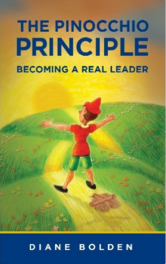
You Don’t Need to Have It All Figured Out to Live Your Dream – Part 1
What do you find easier – dreaming big, or finding a way to make those dreams come true?
Most of us have more difficulty with the latter. If you don’t, you may not be dreaming big enough. But how do you connect the vision with reality?
For years, I was convinced that having a vision and goals meant having a clear and specific picture of what was ahead and designing a plan that would ensure that certain milestones were met at designated intervals.
I was taught that goals had to be specific, measurable, and time bound (and spent a good part of my career teaching others the same). I would spend a considerable amount of time wordsmithing these goals and generating a detailed project plan as though I could bend reality to my will.
And then life would happen and I’d get extremely frustrated when things didn’t fall into place the way I had planned. The part of us that wants to lay out a course of action that minimizes risk and controls all the variables is analogous to a manager, whose function is to plan, direct, organize, and control.
The dilemma is that preconceived ideas of what needs to happen to bring it to fruition can never take into account all the unexpected twists and turns that each day throws at us. So the manager in each of us needs to take its orders from a higher authority.
This higher authority is our inner leader. The leader lives in the present, takes its cues from its inner and outer environment, and speaks to the hearts as well as the heads of its people. It is that part of us that rises up with the awareness that we must make a change in course in order to realize our greater visions. It blends concrete data with intuitive hunches and moves much more fluidly.
“Establishing goals is all right as long as you don’t let them deprive you of interesting detours.”
~ Doug Larson
The manager in each of us often wants to fix things and tends to put more attention on what is wrong than what is right. It is so concerned with problems that it tends to identify with them and unwittingly propagate them. The manager would have us set goals about behaviors we want to stop, and things about ourselves that aren’t good enough.
These goals almost always fail because they lead us to identify with the very state we wish to rise above. We enter into them from a state of deficiency, and though our behaviors may temporarily change in alignment with detailed plans we have crafted for ourselves, our thoughts about who we are and what’s wrong keep us tethered and ultimately propel us to act in ways that reinforce old habits and patterns.
The leader focuses on possibilities and speaks to that part of ourselves and others that has the capability and potential to achieve it. It sees through the eyes of someone who has already achieved their goals and visions rather than identifying with the experience of past failures or shortcomings.
The leader in each of us knows that action follows thought and invests time in identifying limiting beliefs and trading them for something more empowering. Rather than moving away from an undesirable place, it focuses on moving toward what it desires to create.
With the leader in charge, the manager’s willfulness is balanced with willingness – willingness to change and adapt even the best laid plans, to reach higher, and to trust that something greater than ourselves will help us get where we most need to go.
Go to Why You Don’t Have to Have It All Figured Out to Live Your Dream – Part Two.

